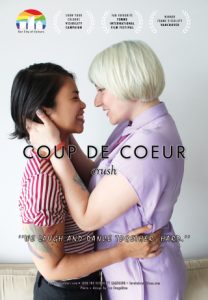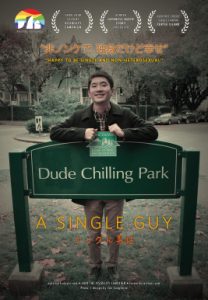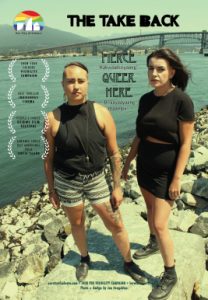For 3 weeks between October 26 to November 15, 2015, the City of Vancouver was graced with the presence of 15 faces of actual queer Vancouverite people of colour featured in mock movie posters. Organized by Our City of Colours, a non-profit organization in Vancouver that at its core seeks to raise visibility and awareness of issues in racially diverse LGBTQ2+ communities, each movie poster was displayed in one of 15 different bus-shelters throughout the city. Posters were also deliberately multilingual in languages including Chinese, Arabic, Swedish, Hindi, French, Italian, Spanish, Korean, Yiddish, Japanese, Ojibwe, Tagalog, and ASL.

Locations of Posters at Bus Shelters
The purpose of this campaign was to show people that there are queer people of colour who exist and live happy lives. Although this might seem to be a rather explicitly obvious statement, the reality is that mainstream LGBT films tend to rarely showcase the stories of queer people of colour. For instance, statistics on the demographics of characters in films from a quantitative study in 2014 by Vanity Fair found that among 4610 speaking characters in the top 100 films of 2014, only 19 were lesbian, gay or bisexual. There were no trans characters. Now, these statistics don’t even account for race yet. Among those same 4610 speaking characters, 73.1% were white, 12.5% black, 5.3% Asian, 4.9% Latinx, 2.9% Middle Easter, less than 1% Native American or Pacific Islander, and 1.2% from ‘other’ racial/ethnic groups. Finally, according to Vanity Fair’s study, from the 700 top-grossing films from 2007 to 2014, only 30% of the 30,835 speaking characters were female.
Scholars who discuss issues of representation and subjectivity are cognizant of the importance of finding avenues to express identities – in this case, queer of colour stories. Cultural, queer and performance studies scholar Jose Esteban Muñoz discuss the notion of (dis)identification with sites of cultural capital as a strategy for queer of colour subjects to disseminate their experiences. In other words, Our City of Colours’ poster campaign decided that building off of the existing resources of bus-shelters and the popularity of movies would be a way for queer of colour stories to survive and persist in Vancouver’s larger community.
Politics of representation mediate how people think and respect one another, and for this reason, the representation of queer people of colour is ever-so important. Notice how one of the posters with the title “Colours in the Wild” features a cowboy who happens to be Black. This representation deliberately attempts to undermine the iconography of the hyper-masculine, white cowboy who symbolically represents freedom, modernity, and conquest in a settler-colonial narrative that is juxtaposed with Indigenous peoples to ‘justify’ their colonization. According to Dr. Beenash Jafri, an American, gender, and sexuality studies scholar, “the racialized cowboy…[throws] settler authority into question” (p. 74).

Jafri further articulates in an article titled “Desire, Settler Colonialism, and the Racialized Cowboy” (2013) that settler colonialism is a “project of desire” (p. 73). In other words, settler colonialism is perpetuated through films by constructing some people as desirable while other people, in this case, Indigenous peoples and some racialized people, as undesirable. While discussing the poster campaign by Our City of Colours, racialized queer people in films are limited in their ability to successfully take on roles of colonial power because of their inability to be seen as white settlers. That is to say, the role of the hero, the savior, or the protagonist are roles limited to white subjects in settler colonial narratives. Because of this inability to be desired, racialized settlers navigate an oxymoronic paradox: being denied desirability produced by the valorization of white settler subjects, while still occupying the role of being settlers on Indigenous lands.
To return back to the larger collective of the 15 mock movie posters and their locations across Vancouver, it is worth mentioning that there is a particular type of political geography at play. Scholars like Paola Bacchetta, Fatima El-Tayeb and Jin Haritaworn discuss how the formation of space is often dichotomized as either exclusively queer or exclusively racialized, without the possible existence of these harmoniously intersecting. After all, highly non-white racialized neighbourhoods are often interpreted to be homophobic or transphobic, while queer neighbourhoods are often racially-exclusive. For this reason, it is important to consider that Our City of Colours had one of their posters placed on Bute and Davie Street in Vancouver, which is known to be Vancouver’s “gaybourhood” – a place that is also known for not being incredibly racially diverse either.
All things considered, why should it then matter that people see themselves, their experiences, stories, and lives represented in film? For many people, to see oneself reflected in popular media humanizes their existence and presents to a larger audience the opportunity to connect on an interpersonal level. Our City of Colours and their mock movie posters campaign starring queer people of colour ultimately acted as a social commentary on the lack of diverse representation in popular films. I can only hope that those who live at the intersections of identities that are under-represented if represented at all, can one day be able to express untold stories, untold hopes, and ultimately, loving desires.
The 15 Movie Posters from Our City of Colours’ Website















Works Cited:
Jafri, B. (2013). Desire, settler colonialism and the racialized cowboy.American Indian Culture and Research Journal, 37(2): 73-86.
Munoz, J. E. (1999). Performing disidentifications. In his Disidentifications, pp. 1-34.
Paola B., Fatima, E., & Jin, H. (2015). Queer of colour formations and translocal spaces in Europe. Environment and Planning D, 33(5): 769-778.
Vanity Fair. (2014). Editorial by Joanna Robinson. August 5th, 2014. “New Report Uncovers
Staggering Inequality for Anyone Not Young White, Straight, and Male in Hollywood.”Retrieved from: https://www.vanityfair.com/hollywood/2015/ 08/inequality-women-race-sexual-orientation-movies
Our City of Colours Website. Retrieved from: http://www.ourcityofcolours.com/posters/